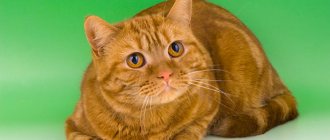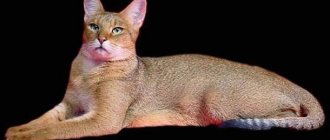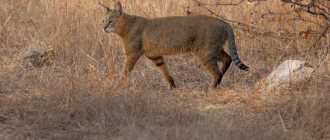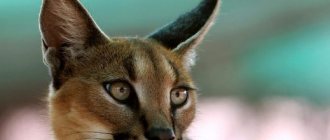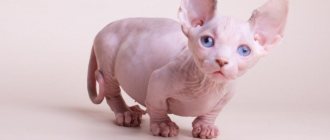History of the species
The history of jungle cats begins when the ancient Egyptians domesticated a subspecies of the cat called Felis chaus. This is a type of African cat, the image of which is preserved on many famous figurines from the times of Ancient Egypt.
The ancient Egyptians domesticated African cats from nearby territories.
These were excellent hunters who brought prey to their masters and replaced dogs as guards. Beginning in the 18th century, attempts began to crossbreed the jungle cat with other representatives of cat breeds in order to breed a pet that could retain a developed hunting instinct combined with an amiable character.
IMPORTANT: Wikipedia indicates that the “reed cat” species was first described by the imperial naturalist Johann Anton Güldenstedt in 1776.
Currently, the wild reed cat lives in more than 20 countries around the world, and the largest representatives of the subspecies have settled in the Caucasus. Reed cats or “swamp lynxes” prefer to live next to people, which often causes discontent among the latter: the wild habits of these animals can deprive the farm of a significant number of small livestock.
The jungle cat, although not ferocious, is still a wild and unpredictable beast
IMPORTANT: the jungle cat is listed in the Red Book of Russia and is protected by law.
The jungle cat is used in breeding, bringing into the world exotic offspring. One of these original breeds is the Chausie - a mixture of the jungle and Abyssinian cat, which was bred and officially registered in 1995.
The photo shows a representative of the Chausie breed
In its pure form, the total number of representatives of the subspecies falls annually, which is associated with continuous deforestation and the death of animals in forest fires, which often burn in the steppe regions of their habitat.
Is it possible to turn a wild animal into a domestic cat?
The cute little predator can be tamed, but only from a very young age. To do this, you need to constantly be close to your pet, have a great desire and patience to raise it. After all, the freedom-loving, independent character of the predator has been formed over many centuries. And a stern disposition is inherent in the nature of survival.
It is possible that the pet will choose only one person as its owner, and will treat the rest of the family members with distrust and hostility. Such close proximity is undesirable for children.
It is better to buy a hybrid kitten obtained by crossing a swamp lynx and an Abyssinian cat.
Chausie kittens, especially the first generation hybrids - F1, can inherit the cool temperament of the jungle cat, but it is compensated by the genes of the affectionate Abyssinian. And the hybrid cat cats F2 and F3 already have the usual: sociable and kind character of a domestic cat.
Appearance and features
At first glance, the jungle cat is not much different from an ordinary pet, but this is a misconception. The appearance and character of animals have differences that are most clearly determined by the description of the breed.
Cats of this subspecies have many similarities with other felines.
Dimensions and weight of jungle cats
The size and weight of the animal indicate that the jungle cat is somewhat larger than domestic felines. The body length of a jungle cat can reach 50-95 cm, and its weight does not exceed 15 kg.
Anatomical features
This subspecies of felines has a very developed body structure, especially the muscles that are always in good shape, as well as strong and long paws, thanks to which the animal moves deftly across any terrain. They move quickly and gracefully across the surface, jump high and skillfully climb trees.
This type of cat has pronounced yellow or green eyes.
The animal's tail has a black tip, but is not particularly long or thick. The ears are decorated with graceful tassels, and their height, in some cases, can reach eight centimeters.
Color
The animal's coat is short, with a thick undercoat, which has the unique natural property of quickly removing dirt and strong water-repellent ability. In summer, jungle cats “dress up” with shorter fur, and in winter their coats become fluffier. Often the color of the animal is a gray-red camouflage.
The color of the jungle cat helps it camouflage and hunt in natural conditions
What does a jungle cat look like? Dimensions and weight
The jungle cat is a graceful, long-legged, medium-sized cat. This is the largest representative of the Cat genus that has survived to this day. House cats are noticeably larger in size than domestic cats and have a more refined build.
The length of the animal’s body including the head ranges from 59 to 76 cm. The height of the predator at the withers is approximately 36 cm, weight varies from 2 to 16 kg. The cat's size decreases from west to east, and similarly from north to south. Thus, the smallest Hausas live in Southeast Asia. The difference in size depending on habitat is explained by higher competition among cats in the southeast. Females are usually smaller in size than males.
The cat has a long and narrow muzzle, with white fur near the mouth. The long ears, 4.5 to 8 cm high, are set close together and have small tufts of dark hair at the tips of the ears. The eyes are yellow, with a narrow long pupil, like those of domestic cats.
The tail, 21 to 36 cm long, is marked with 2-3 black rings towards the end and a black tip. The legs are long: in one step the predator covers an average of 29-32 cm. Due to the long legs, tufts on the ears and the relatively short tail, the house looks like a small lynx.
The color of the cat is uniform, without spots, the color of the fur varies from sandy and light yellow to red-brown and gray shades. Black and white jungle cats, that is, albino and melanistic animals, are found mainly in India. In terms of fur color, jungle cats resemble caracals and African wild cats.
Kittens are often born spotted and striped; the pattern may be partially preserved into adulthood. There are 4-5 dark rings on the back of the front legs; they are hardly noticeable from the front. The fur on the belly is usually noticeably lighter than the color on the back and sides; the fur on the throat is quite light. The fur on the back is noticeably thicker than on the underside of the body. Winter fur is noticeably thicker and denser than summer fur.
Features of character and lifestyle
The jungle cat is a wild predator whose habitat has taught it to live and survive in harsh natural conditions. The character of the animal is also formed here, which is inherited by its direct descendants by genotype.
Determination, pride and intelligence, heightened by the survival instinct - all this forms the basis of the jungle cat’s character. Such a pet will not put up with an encroachment on his personal space and will not obediently tolerate an attitude that seems unacceptable to him. The wild nature has forever programmed in these animals a pronounced desire for independence. The jungle cat will defend itself and its territory to the last.
Jungle cats are especially fierce in protecting their offspring.
IMPORTANT: jungle cats can act very domestically; in particular, they meow and purr in exactly the same way as regular domestic cats.
One of the most pronounced traits in the character of the jungle cat is a love of solitude and a nocturnal lifestyle, which is why the cat sleeps a lot during the day and is awake at night. For rest, the animal chooses a warm and safe place for itself, since it does not perceive cold well and is not at all adapted to sub-zero temperatures. Most of the time, jungle cats lurk in dense thickets, where they hide from stronger competitors (wolves, large dogs and leopards).
With the onset of darkness, they go out hunting, skillfully pursue prey in long runs and deft silent attacks, are not afraid of water, are excellent at catching fish and generally have extraordinary hunting skills.
The nature and character of gray representatives
Males and cats of gray color are real dark cardinals among their kind. They are balanced, calm and dignified. They do not accept familiarity and prolonged active play. These animals forgive humans a lot, but only when they feel the love and care of their owner. If gray cats decide to take revenge, they “plan” it carefully and carry out vengeful actions with a time delay.
Nibelung
Many breeders note the high intelligence of gray cats. Such animals love to be leaders, but they rule softly; if necessary, they prefer to retreat in order to maintain their own calm. Breeds with ash and steel tones will appeal to bachelors, elderly people, and those who lead a measured lifestyle.
Is it possible to keep a jungle cat at home?
At first glance, it may seem that such an idea is nonsense and it is impossible to train a wild animal. This is partly true, but still cases of keeping a jungle cat at home exist and are successfully practiced with one condition: the future pet must get used to living together with a person from the first months of life. Otherwise, the training enterprise is doomed to failure and it will be almost impossible to curb the wild nature of the animal.
The jungle cat can become a pet and an exotic decoration for the home, but this will require a lot of time and effort.
Many people, in pursuit of the exotic, forget that some breeds are bred and evolved directly for domestic conditions, but not all types of cats are able to adapt to life in captivity. The jungle cat is one of those closest relatives of cats that was created by nature for a wild habitat. He cautiously and warily welcomes human society, and will perceive any attempts to limit freedom as a threat to his own safety. It is for this reason that jungle cats are purchased as one-month-old kittens, subject to patient and long-term care for the animal. Only in this case is there a real chance of raising a pet that will peacefully and obediently coexist next to a person.
IMPORTANT: we should not forget that surrounded by human care and the best living conditions, the jungle cat forever remains a wild predator.
Originality in care
Combing
The animal should be combed three times a week, and only during shedding, do it every day. The indoor cat has an erratic shedding schedule. Sometimes in winter he does not have a thick undercoat, because the living space is well heated. Summer, on the contrary, can be cool, so the cat can begin to “warm up”. In other words, if you see a lot of loose fur, you should start combing. To do this, you need a special brush with soft bristles.
Bathing
An animal that does not go outside does not pollute its fur much, so it does not require frequent bathing. Water procedures are necessary after wet weather.
Nail trimming
To prevent your cat from scratching the furniture, give him two scratching posts. Thanks to them, you won’t need to trim your pet’s claws, because he can handle it himself.
Walk
A country house is the most suitable place to keep a jungle cat. This is where you can jump and run. But if an apartment pet lives in other conditions, it must be walked outside. Since this is not a dog, it is not worth going for walks every day. But we should not forget about the natural rays of ultraviolet radiation, they are very beneficial for his health. In addition, it is impossible to throw out your energy in the small space of an apartment. This leads to excess weight of the animal and resulting diseases. This means that in good weather, always take your pet outside.
The right diet
The jungle cat does not require special nutrition, although in order for its health not to fail, it needs to eat well. An animal that is under one year old should be fed twice a day, and then once.
Do not forget that your pet is a hereditary predator and its diet must include live food. Then he will grow up full and healthy. To do this, he needs to be given two small mice or one rat - mandatory, and in addition two hundred grams of lean meat.
In addition to meat, the diet should include plant foods.
- Most of the food should consist of meat. In nature, these cats successfully catch birds, nutria, sometimes hares and even wild boars.
- Once a week, give your pet fish, but only boiled fish. A large amount of fish in the diet leads to calcium loss and rickets.
- It is preferable to make the third part of the food plant-based. Sometimes the jungle cat himself asks the owner for fresh vegetables and fruits. Don't ignore his requests, pamper him with something tasty.
Due to the fact that a pet does not expend enough energy like an animal in the wild, it is therefore more prone to becoming overweight. There is an exit. Take a fast day once a week. Then the animal will not become obese.
In addition to proper nutrition, cats need to add vitamins and minerals to their food. This should be done if your pet eats special food, as well as store-bought meat, and does not receive “live” food in its diet.
You should not resort to cereals in your diet, because cereals in any form are very difficult to digest. When purchasing dry food, carefully read the composition, as it also contains grains. For a jungle cat, you should select only specialized premium food.
Features of care
The jungle cat is by no means hardened by a “sofa” lifestyle, therefore it has excellent health and physical indicators that are the envy of all domestic cats. The nuances of the conditions of detention include several points:
- Rabies vaccinations are at the top of the list of jungle cat care obligations;
- Walking in the fresh air is an obligatory part of the animal’s lifestyle; the jungle cat gets used to a leash and harness without much persuasion;
The jungle cat needs frequent walks and exercise.
- Keeping such a cat in a cramped environment is a very bad idea: the animal needs space with a variety of games and entertainment;
- It is important to support your pet’s hunting instinct so that it does not get bored and does not begin to show unreasonable aggression: sometimes you can buy a live mouse or fish at a pet store, which the cat will happily hunt;
- Mixed breeds of this type are kept in comfortable enclosures equipped for natural conditions;
- Bathing for such an animal is a true pleasure, so it is advisable to open the swimming season for it at least once every two months;
Jungle cats love to swim and hunt in water
- At home, jungle cats are prone to weight gain; for this reason, the pet’s diet should be strictly controlled;
- It is necessary to comb out the jungle cat during the seasonal molting period; a furminator copes best with this task;
What and how to feed
Dry food, even the best premium quality, will not please a jungle cat. His diet should consist of natural products: lean lean meat, plant foods, vitamin supplements necessary to maintain health, and unprocessed live food (with skin, blood, feathers).
Feeding your pet periodically should remind him of wild hunting in the field.
Reproduction
The mating season for jungle cats begins at the end of winter and beginning of spring: males make their “serious” intentions known with a loud sound, thereby attracting females for mating. After this, pregnancy begins, which lasts no more than two months.
Newborn kittens grow quite quickly and soon gain their own independence.
Typically, no more than five kittens are born in one litter and, characteristically, both parents take care of them in the future. Already at the age of one month, babies turn into independent animals, they can eat and even move without assistance. By six months, they turn into skilled hunters and are finally separated from their parents.
Pros and cons of this cat breed
Buying a jungle cat is a serious and controversial step with an unpredictable outcome. You can get a domestic cat that will be quite habituated and friendly to its owner, but it is also possible that the slightest flaws in the educational process will give vent to the animal’s wild temperament. In the latter case, he will be aggressive, poorly trained and reluctant to listen to the demands of his patron. In general, the idea of taming such a wild animal is a conscious step that will require a lot of patience and constant effort on the part of the owner.
Gaining the respect of the jungle cat is a task for real enthusiasts
- The owner, who has managed to replace the kitten’s parents, has every chance of becoming its closest and most trusted guide to the outside world;
- Many breeders are attracted by the originality of the animal, whose wild essence clearly contrasts with the habits of a domestic cat acquired during the process of upbringing;
- All educational measures are applied promptly at an early age: reed kittens are very smart and quickly understand the essence of the requirements;
- A jungle cat will be able to accept human authority, but only on condition that the owner takes into account his natural characteristics;
Choosing a nickname for a gray pet
The choice of name is largely influenced by the breed, unique morphological characteristics, habits and cat’s character. After all, regardless of age, any cat, when communicating with people, shows its individuality and its behavior suggests that a specific nickname suits it.
Fluffy kitty Sonya has turned into a cat who loves to sleep
For your information! Many cats, who were brought into a new family as weak kittens, received the name Sonya because they slept almost around the clock.
Nicknames based on the pet's character
Having taken a closer look at the new inhabitant of the house and analyzed his basic behavioral inclinations, it is much easier to give him a name. And yet, when choosing a nickname, you need to focus on very short or two-syllable words. Even if it was previously decided to name the smoky cat Mercedes because he chases a paper bow tied to a long string at the speed of a car, it is unlikely that his name will not be changed into the short nickname Merc.
Important! In the animal's name, it is desirable to have sounds reminiscent of the squeak of rodents “z”, “s” or “ts”. The main quality of all cats and kittens, which they inherited from wild nature, is their independence and love of freedom. Even the most well-mannered animal will, on occasion, sneak out through a loosely locked door into freedom.
The names Frida and Frid (from the English freedom - freedom) and the Russian versions of the names Volya and Volka are very suitable for cats running onto the balcony through the window and cats walking on the roofs of houses.
Even the most well-mannered animal will, on occasion, sneak out through a loosely locked door into freedom. The names Frida and Frid (from the English freedom - freedom) and the Russian versions of the names Volya and Volka are very suitable for cats running onto the balcony through the window and cats walking on the roofs of houses.
The main quality of all cats and kittens, which they inherited from wild nature, is their independence and love of freedom. Even the most well-mannered animal will, on occasion, sneak out through a loosely locked door into freedom. The names Frida and Fried (from the English freedom - freedom) and the Russian versions of the names Volya and Volka are very suitable for cats escaping to the balcony through the window and cats walking on the roofs of houses.
A soft gait, elegance and grace, beautiful smooth curves of the paws and tail - these characteristics are inherent in all cats, but not all of them demonstrate their beauty to their owners persistently and uncompromisingly, asking for stroking behind the ears. And if the owners call such a cat Slender (English slender - graceful), then they will not be mistaken in his description. Well, for an elegant gray cat-girl, the name Gabby is undoubtedly suitable - in honor of Gabrielle Bonheur Chanel.
An Abyssinian cat who really suits the name Shanechka, Shanya in honor of Coco Chanel
For lively, frivolous kittens who can jump onto a closet and hang from a chandelier in a raid, cool names have been invented: Shustrik, Storm, Hooligan, Hurricane, Typhoon, Bandit, Barmaley, Butuz, Zipper, Murzik, Kuzya, Vintik. Fast cats are called Gazelle, Zhuzha, Bully, Storm, Gulya, Bullet, Mulya, Jump rope, Nut, Tsunami.
Calm, slow, phlegmatic cats are nicknamed Bourgeois, Tsar, Caesar, Eremey, King, Barin, Lord, Count, Narcissus, and for cats with such inclinations - Lady, Tsypa, Bagheera, Manya, Lipa, Motya, Fima, Sultana, Marquise, Milady, Signora, Shahinya.
The name Smokey is suitable for a gray boy kitten who is constantly begging for food. Names for all cats and cats who love to eat will be interesting - Sausage, Bar, Donut, Obzhorka, Jerboa, Cake, Pie, Bagel, Bun, Porridge, Tsatsa, Charlotte, Dunya, Toffee, Bean.
Note! If the sounds “m” and “r” are present in a cat’s name, they will attract the animal’s attention because they will remind them of purring
Buy a jungle cat kitten
Buying a jungle cat kitten is not an easy task. Most often, hybrid breeds are bred and sold, usually Chausie cats and other exotic breeds.
When choosing a kitten, you should pay attention to its cleanliness and grooming.
There are specialized nurseries that provide purebred representatives of the subspecies. Sometimes jungle cats are found at elite exhibitions. The kitten will cost at least $4000-5000. You can take a pet into your home from the moment it turns one month old. It is not recommended to purchase an older kitten: there is a possibility that the animal will not become accustomed to living conditions at home.
Origin story
In Russia, the jungle cat was previously found on the coast of the Caspian Sea, but was last seen in its traditional habitat in the 1980s (according to IUCN). However, there were times when the wild jungle cat was by no means exotic, but a ubiquitous phenomenon.
It is believed that the swamp lynx, which lives on the banks of the Nile, was the first to reach people about three thousand years ago. People (ancient Egyptians), tried to get a lot of benefits from their acquaintance with the reed cat - the reed cat not only lived in their houses, but also went with game hunters.
On the surviving scrolls you can see how Cat House hunts ducks and even swims to get prey from the river. In fairness, it must be said that only the Egyptians were able to tame the wild purr; all subsequent historical evidence suggests that people avoided jungle cats.
Moreover, they were considered dangerous for their farms, in particular for domestic muskrats and pheasants, which were attacked by predators. Therefore, there was a constant capture of wild cats, whose skin was in demand.
And although 9 subspecies of the reed cat are registered in the world today, in fact, you will not find a single one in the reeds!
Description of the breed
| Breed name: | jungle cat |
| Country of origin: | middle Asia |
| Time of origin of the breed: | 18 century |
| Weight: | 10 – 14 kg |
| EMS code: | – |
| Lifespan: | 10 – 14 years |
| Price of kittens: | 3000 – 15000 $ |
| The most popular nicknames: | list of nicknames for the jungle cat |
The paws are high with very sharp claws, the tail is small, its length is no more than 30 cm. The head has large, triangular ears, with tassels at their ends, like those of a lynx.
Thanks to this, the animal received its second name “swamp lynx”. The upper part of the body is gray-brown with a reddish tint, the lower part is light.
The tail is darker than the body with several brown rings and black at the end. The muzzle is reddish, only the chin is white. Kittens are striped, but on the body of adults the pattern appears poorly. In summer the fur is short, in winter it is thick and lush.
Breed standard - appearance
Since the wild jungle cat is not a breed, there is, of course, no standard for it. But Wikipedia can help us - a detailed description of the House in the publicly available multilingual universal Internet encyclopedia introduces the appearance of this representative of the cat world.
- The head of the Hausa is massive.
- The muzzle is elongated.
- The ears are large; adults have tufted ears. The ears on the reverse side are decorated with “false” eyes.
- Eyes yellow or green.
- Jungle cats, with fairly long paws, have a short thin tail, proportionally accounting for about a third of the body length.
- The body itself is powerful with a wide chest.
- The coat is smooth, short, very thick.
- Color is the main difference between those same 9 subspecies. But the main colors are black, ticked tabby/silver.
If you carefully study the photos of the houses, you will see that the color is uneven. The belly and tail are less pronounced in color than the head and back of the animal. Sexual dimorphism is striking in this family.
Males are always larger than females. Usually at the withers they reach half a meter, in length (including the tail) sometimes 124 cm. The weight of an adult house is about 14 kg (a cat weighs less - up to 10 kg).
